Kashin - A town in a loop
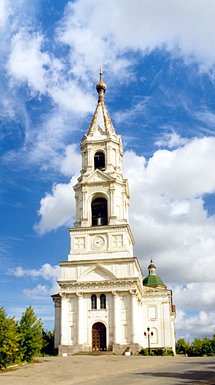 |
Voskresenskii Sobor
(Resurrection Cathedral).
Photo: V. Salov |
Kashin is a little town with a long history, famous by a very unusual town plan.
The whole town is cut by the river Kashinka, which meanders through Kashin, making amazing curves, almost loops. There is a point where it makes a very narrow neck, which has just enough place for one street. From this street, you can see the same river both at your left and at your right.
At the end of 18th century, Kashin got a new rectangular grid of straight streets, which are running north-south and west-east. Many streets dead-end in the hills with churches on top. Put it in this way: The town results from joint efforts of the unconstrained creativity of nature and the linear thinking of humans. We also note that it is much less bridges in the town than just places where a street stops at the river bank. The town center lies closely to the bottleneck of the loop. You can recognize it by finding the Voskresenskii sobor (Resurrection Cathedral), which, you may be sure, is built on the top of a hill.
Long time ago Kashin was surrounded by woods; nowadays, they have given place to agricultural countryside, which covers the neighboring hills.
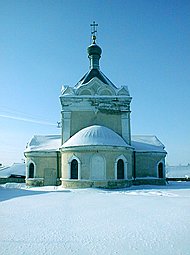 |
Khristorozhdestvenskaya Tserkov'
(Christ Nativity Church).
Photo: V. Salov |
Today's Kashin is an appealing provincial town. It stayed outside the battlefields of the WWII, however, the town center was considerably altered. New residential areas consisting of five-floor block buildings were built, and the old houses are somewhat lost in between. The reason for that was the decision to demolish a number of monasteries and churches to give way to residential and industrial construction. Close to the center, a factory was built with the shops which can hardly be considered as art masterpieces. As in most other Russian towns, the streets of Kashin were renamed in the communist times. However, "Street of Red Ideas" and "Renewed Labour Street" can be regarded as chef d'oeuvres of the genre. Old town fortifications are practically invisible: Wooden ramparts and towers have burned long ago. In some places one can recognize remains of the earthworks.
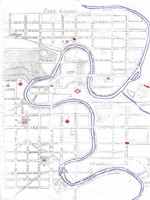 |
| Map of Kashin |
A backwater sometimes shows a traveller a nostalgically pleasant side, as if we have returned to the long-gone time when Russians were smiling to each other. Such a thing happened to us in the Kashin regional museum. We were the only visitors that day, and they led us by hand through the rooms for a long time, explaining us the history of the town, and before we left, they gave us a present - a hand-drawn map of the town (shown on the right) colored by wooden pencils. They had a pile of such maps at the reception. In the end of 20th century, at the time of global computerization, when even the letters to family and friends are keyboard-written, it was such a pleasure to have in hands something home-made, which still kept the warmth of human hands. Apparently, the girls did not understand my confusion and started to apologize for not being civilized enough ...
Although Kashin is pretty and has its own charm, the tourists are not really heading here in big numbers. Presumably, this is because it is somewhat far from other tourist attractions, especially the Golden Ring. The town is dominated by stone buildings, including the modern ones. Of all industrial enterprises existing in the town the most successful (as of 1998) is the vodka plant, with the production being the joy of the eyes (and probably not just eyes - A.T.) of the fans of this drink.
History
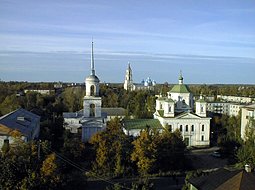 |
Kashin. The panorama of the town.
In front: Voznesenskii Sobor
(Ascension Cathedral).
At the back: Voskresenskii Sobor
(Resurrection Cathedral).
Photo: V. Salov |
The part of the town's history available to us starts with the troubles which overtook Kashin in 1238. It is listed among the fortresses taken by Mongols. According to the tradition, the age of the town is counted from this year, though, beyond any doubts, Kashin existed before. Concerning this "pre-history", various versions exist. Locals mention sometimes that the town was founded by Yurii Dolgorukii (the Vladimir prince who founded Moscow). This idea is certainly expected to be accompanied by the notion that Kashin is the same as Moscow, just a bit better. Other versions put the foundation of the town to 12th-13th centuries.
Apparently, the town owes its name not to the gastronomic tastes of locals (kasha is one of the most famous entries of Russian quisine), but rather to the river Kashinka, on the banks of which it appeared.
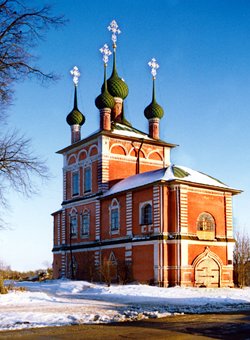 |
Il'insko-Preobrazhenskaya Tserkov'
(Church of the Transfiguration of St. Ilia).
Photo: V. Salov |
The most heroic parts of the Kashin history date back to the time of wars between the rivals Moscow and Tver', when the primacy in Russian lands was at stake. The town represented the Tver's interests at the north-east frontier. In 1288, the Vladimir prince Dmitrii Alexandrovich, having organized a coalition, put a siege around Kashin. The town, however, managed to repel the enemies, though the siege has caused a considerable economic damage.
From the beginning of 14th century the town continued to grow. Moreover, Kashin became a center of a principality. The prince was Vasilii Mikhailovich, whose father, the Tver' prince Mikhail Yaroslavich, was murdered by Tartars in Orda. The Kashin principality was pursuing the policy of supporting Tver' and had to struggle with the two enemies at the same time - Tartars and Muscovites. The subsequent fate of the town is very instructive. Vasilii Mikhailovich was promoted and became the prince of Tver'. This happened in the middle of 14th century. At that point, it became clear that not all of his kin are very happy about this development. Prince Vasilii gets domestic enemies. He loses the Tver' seat and discovers that he has got some friends. Yes, the same friends whom he already had a war with - princes of Moscow. Now they have a common enemy - Tver'.
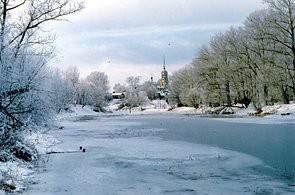 |
River Kashinka and Krestovozdvizhenskaya Tserkov'
(Church of Erection of the Holy Cross).
Photo: V. Salov |
Descendants of Vasilii went on with the blessed activity of hunting down the relatives, and finally they succeeded. Vasilii Mikhailovich the Second together with the Dmitrii Donskoi (the prince of Moscow, famous for the win over the Tartars at the Kulikovo Field) defeated the former metropoly, got independence (for 7 years) and contributed to the establishing Moscow as a leading Russian force.
In 1382, Vasilii Mikhailovich the Second died, and Kashin joined the Tver' principality again. From 1399 to 1426, Kashin was again the center of principality, which facilitated new intrigues against the capital.
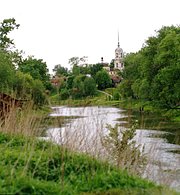 |
River Kashinka
and Krestoznamenskaya Tserkov'
(Church of the Sign of the Holy Cross).
Photo: V. Salov |
In 1426, Boris Alexandrovich, the prince of Tver', lost his patience and abolished the Kashin principality. In 1452, Kashin was sieged by the prince of Galich, Dmitrii Shemyaka, famous for having blinded his brother, the prince of Moscow Vasilii Kosoi, and usurping his seat. However, the fortress proved to be too strong for him. Finally, in 1485 the prince of Moscow, Ivan III, put the end of Tver's independence and appended it to his domain.
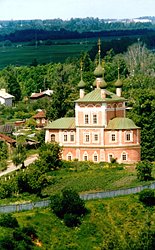 |
Il'insko-Preobrazhenskaya Tserkov' (Church of the Transfiguration of St. Ilia).
Photo: V. Salov |
In 16th century, the town was developing relatively quietly far from the big politics. The 17th century brought it new ordeal.
In 1609, Kashin was taken by the Polish-Lithuanian army, and eventually liberated by Russian troops. In 1612, Polish took it again and subsequently destroyed the town almost completely.
The town started to get its contemporary face in 17th century, as stone construction flourished. Kashin was a tranquil trade and craft town, performed fairs, produced brickstones, whiting, and ironwork. Merchants played an important role: They not only built their mansions, but also sponsored construction of churches and monasteries, which make the town so famous nowadays. From 1884, the resort was established on the local spa.
Attractions
 |
| Vkhodoierusalimskaya Tserkov' (Church of the Entry into Jerusalem) |
Voskresenskii sobor (Resurrection Cathedral) - "The dominant point of the town". Built in 1382. Now is situated in the very center of the town. It was rebuilt many times, with the present appearance dating from 19th century. In the past, it was a part of the ensemble of Kashin Kremlin.
 |
| Krestoznamenskaya Tserkov' (Church of the Sign of the Holy Cross) |
Klobukov Monastery. At the time it was built, it obviously was located outside the town, but now we find it deep within the town limits. In the monastery, a number of buildings survived: Troitskaya Tserkov' (St. Trinity Church), some civil buildings, Pokrovskaya Tserkov' (Intercession Church), and Alekseevskaya Tserkov' (St. Alexius Church).
Dmitrievskii (St. Dimitrios) Monastery is mostly famous for the Troitskii Sobor (St. Trinity Cathedral). Most of the other buildings were destroyed by the time.
At the premises of Sretenskii (Meeting of the Lord) Monastery (one more) Troitskaya Tserkov' (St. Trinity Church), priory, and cells survived.
 |
Tserkov' Ioakima i Anny (Church of Joachim and Anna)
(burned 1998) |
Churches and old merchant mansions are spectacularly scattered around the town.
Of the major interest are Vkhodoierusalimskaya Tserkov' (Church of the Entry into Jerusalem,1777) (currently a museum) and Krestoznamenskaya Tserkov' (Church of the Sign of the Holy Cross, 1721-1784). Worth attention also are Voznesenskaya Tserkov' (Ascension Church, 1799) and the building of the district court from the end of 18th century. Very spectacularly are located the trading galleries, which open fine views of surrounding streets and hills.
We are awfully sorry to write that the most beautiful and, also, the most ancient building of the town - the wooden Tserkov' Ioakima i Anny (Church of Joachim and Anna, 1646) - burned in the beginning of 1998 as a result of "unintentional arson".
|